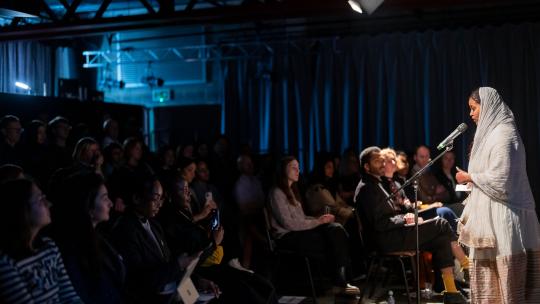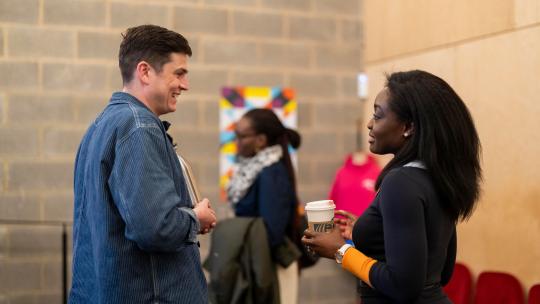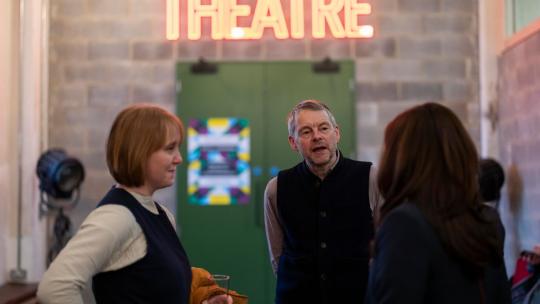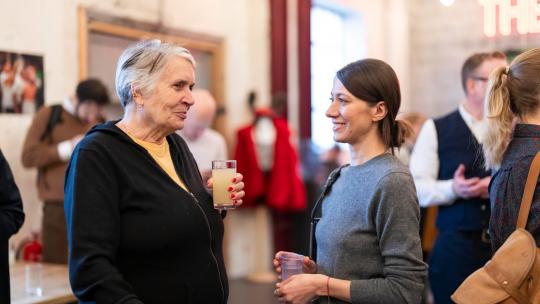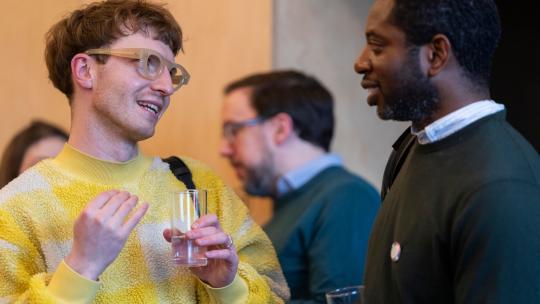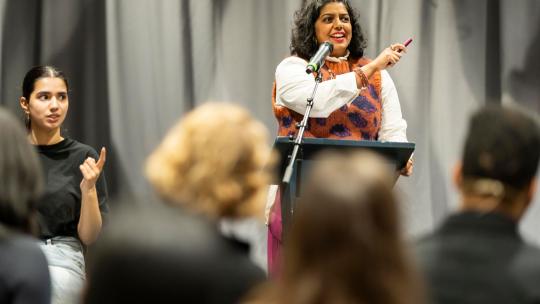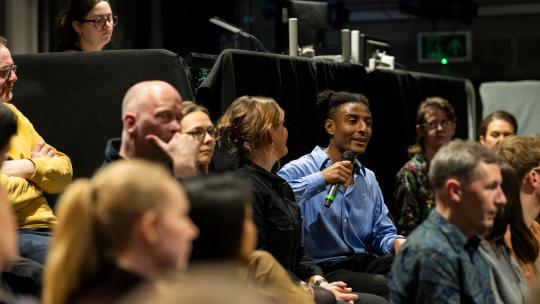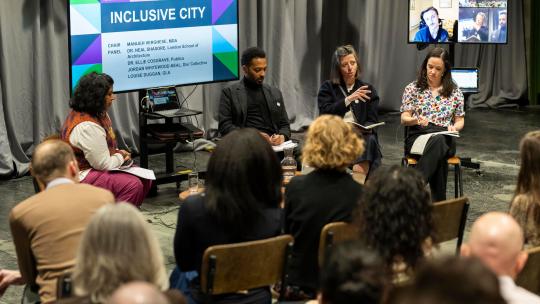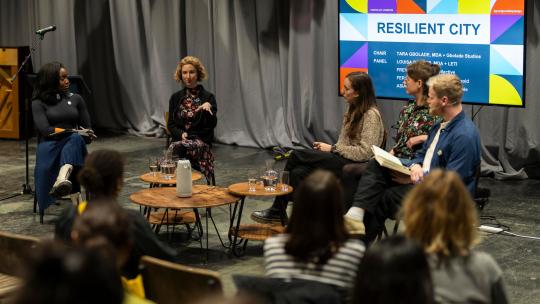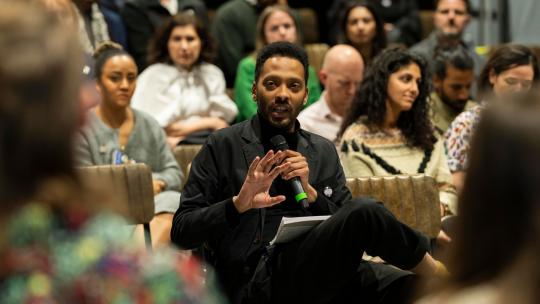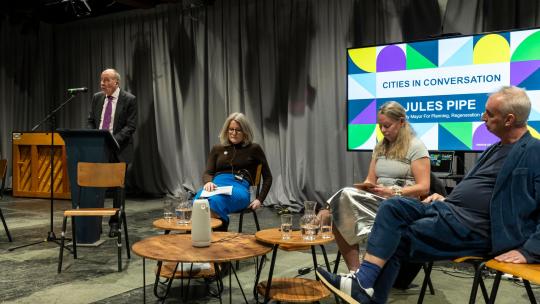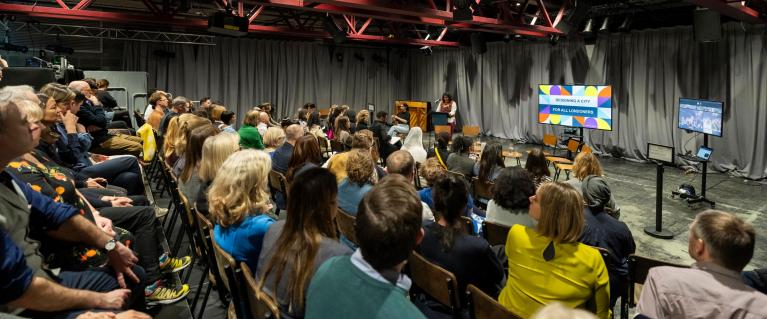
Good Growth by Design: looking back and forward
On 6 March we hosted a ‘Designing a City for all Londoners’ symposium at the National Youth Theatre.
This brought together guests with diverse roles in shaping the built environment, to reflect on the achievements of the Good Growth by Design programme over this Mayoral term. The symposium also helped us to look ahead at key opportunities and challenges. Here are 10 takeaways from the presentations and discussions.
1. Education and life-long learning to bridge the environmental skills gap
There are acute skills shortages around the evolving environmental and building safety agendas, and we must work to prepare the sector to meet the challenges of the future.
Greater sharing of knowledge, and much closer collaboration between disciplines will be needed to meet the challenges for the future. Dr. Neal Shasore, Head of School and Chief Executive of the London School of Architecture, set out how post-Grenfell policy responses have underscored the need for educational reform and for architects to learn new skills, particularly in regard to retrofit practices.
Chairing the ‘Resilient City’ discussion, Mayor’s Design Advocate Tara Gbolade, said “We can only give the gift of London to future generations if we respect planetary boundaries. Even established architects need to re-educate themselves to meet the challenges of the future”.
We will all need to adapt our practices to meet the climate emergency, this means asking difficult questions, being open, and sharing knowledge as we learn through projects.
2. Supporting the sector on the pathway to Net Zero Carbon
“Decarbonisation and resilience are interlinked. With retrofit, we can potentially reduce the Carbon Emissions of existing housing by 70 per cent, and it can be less costly and provide people with healthy homes too." – Fergus Anderson, Buro Happold.
The Mayor of London, Sadiq Khan, has set a target for London to be net zero carbon by 2030. The Good Growth by Design programme commissioned Allies and Morrison and Buro Happold to undertake a comprehensive study of net zero carbon design.
The research is supported by an extensive call for evidence from architectural projects which demonstrate exceptional environmental design credentials, both within the United Kingdom and abroad. Drawing from 100 responses, these projects have informed an analysis of the challenges that projects face, and how they can be overcome.
Through this research we can share data and learning on exemplary schemes, to debunk some of the myths surrounding designing for Net Zero, such as the perception of excessive costs, technical difficulties, and procurement complexities.
3. We need new infrastructure to enable the circular economy to grow
Since 2021 we have required all new major developments in London to carry out whole lifecycle carbon and circular economy assessments. This is helping to embed the circular economy within the industry and helping us to progress on the pathway to Net Zero Carbon by 2030.
“The most important thing is to try and preserve as much material as we possibly can at the highest quality, within the place it is in. That's going to be the most impactful thing that we can possibly do in our work as designers. And if you can't do that, make sure that you've done the audit and you know where those materials are going at the next stage of their life.” – Louisa Bowles, Sustainability lead at Hawkins\Brown.
There are many inspiring examples of organisations testing and implementing circular economy approaches, from hyper-local materials exchanges for community projects, to contractor-led initiatives that respond to the opportunities of large-scale urban development. Repurposing and using recycled materials are key strategies to making carbon savings.
An infrastructure of sites, logistics, relationships and networks is needed to coordinate and develop London’s nascent circular economy. This includes working with the supply chain to create well-managed materials banks that can process and redistribute material to sites across London. Freya Bruce, member of Re-Collective shared their approach to ‘anticipatory design’ which involves auditing and diverting materials that would otherwise enter waste streams.
4. Continuing to share best practice through design research
Through the efforts of the Mayor’s Design Advocates, partners and practitioners in the wider sector, the Good Growth by Design Programme has developed a suite of research and best practice policy and guidance to help ensure the city’s future meets the needs and aspirations of all Londoners.
Our design research capacity helps drive innovation and advocates for fresh, progressive thinking. Practically, this guidance also demonstrates the deliverability of policies and supports best practice.
As just a few examples, this includes the design guides for ‘Making London Child Friendly’, ‘Expanding London’s Public Realm’, and the ‘Public London Charter’ which sets out eight principles for ensuring London’s public spaces are safe, accessible, inclusive and attractive.
Most recently, we have produced the following research and guidance: ‘Women, girls, and gender diverse people – safety in public space’, ‘Designing space for Culture’ and ‘Designing for disabled Londoners’, which is soon to be published.
5. Inclusive design is a process, not a product
Dr. Ellie Cosgrave, Director of CIC and Research at Publica, described the three ‘lenses’ of inclusion: Accessibility, ie can everyone use this space equally; freedom from violence harassment and intimidation; and a sense of belonging, ie is this for and by someone like me. She challenged us to locate where everyday forms of exclusion exist and how we can consciously push against them.
Jordan Whitewood-Neal from dis/collective highlighted the importance of inclusive language practices, “not everyone society labels as ‘disabled’ considers themselves that way”.
The ‘Inclusive City’ panel discussed how we will need to develop new skills and ways of working to become more inclusive, and reinforced the importance of lived experience forming the basis of a design process. That is both through a diverse design team, and through participatory practices. Co-design and co-production are increasingly common requirements in public client’s briefs as they enable authorities to share power with those who will be affected by, and also benefit from, development processes. As Dr Ellie Cosgrave said, moving beyond representation and inclusion, “it’s about all of us getting better at listening to, and believing what people say, and taking that as evidence of experience”. This is not an easy process and requires us to approach differences with openness and curiosity, and to address conflict with compassion.
By fostering meaningful engagement and collaboration between residents, planners, and architects, we can create spaces that reflect the diverse needs and aspirations of the people who inhabit them.
“We need to act with urgency, take ownership, and use the expertise you hold to bring voices into a design team meeting.” – Dr Ellie Cosgrave, Publica
6. We need an intersectional approach to designing and shaping the places of the future
A diverse sector is vital to meeting the challenge of the poly-crisis we are living through. The built environment industry should reflect London’s diversity and we must take an intersectional approach to addressing the climate emergency, “If monoculture got us into the climate crisis, diversity of all kinds has to be part of the solution” – Dr Neal Shasore.
Climate inequality is one of the major global challenges, and it affects Londoners too. The most deprived communities of London still more commonly live in the most polluted areas, however concentrations have declined faster in areas of deprivation and more markedly since 2016. To address this, we must all approach sustainability and resilience within the built environment through the lens of climate justice.
7. Broadening authorship of the city
We have all heard the Mayor speak about London’s strength being down to the diversity of its communities, but we also know we still have a way to go in reflecting that full diversity within the built environment. For example, women, people from Black, Asian and Minority Ethnic backgrounds, and disabled Londoners, are chronically under-represented in built environment professions. And we know in a city as diverse as London, an unrepresentative profession is a profession that misses out on the full perspectives of its citizens. Yet the racial and socioeconomic barriers to access and progression in built environment careers have remained high. The aim should be to address the precarity of young and emerging practices and practitioners, where the most diversity in the industry is, and where significant fresh thinking and innovation is held.
"Our A+U procurement framework, provides a more representative, pre-approved panel of built environment consultants to help public commissioners embed principles of quality and diversity" – Lucinda Turner, Assistant Director of Planning and Regeneration.
44 of the 97 places were reserved for micro and small enterprises – the types of companies that are most associated with diverse ownership. The Framework has broadened the range of practices able to tender for public contracts through measures such as reducing Professional Indemnity insurance requirements and turnover thresholds by assessing financial risk differently.
8. Getting our own house in order
We aim to lead by example on publicly owned land, and demonstrate how we invest public money to secure public benefit.
“Making great cities is about culture – never just policy and procedure” – Claire Bennie, Director of Municipal.
As one of the Mayor’s Design Advocates, Claire Bennie has helped us carry out a Design Maturity assessment across the GLA’s four development arms to help us enhance culture and processes. This will ensure consistency and quality in how we deliver Housing on Mayoral land, and it is one of the many design quality management actions catalysed by the Kerslake Review.
In his presentation as part of the ‘Cities in Conversation’ segment, Paul Monaghan, Liverpool City Region Design Champion, shed light on some of the innovative strategies employed in Liverpool. He shared anecdotes of how, through his orchestration of a ‘Townhouse of the Future’ ideas competition, open to Liverpool-based architects, the local design sector was boosted. The competition also gave a platform to the winner, Harrison Stringfellow, an emerging women-led practice.
“Every major city should have a design champion. It's not an autocratic job, it's about being collaborative and encouraging.” – Paul Monaghan, Liverpool City Region Design Champion
9. The new Design Unit will embed a culture of design excellence in London
The formation of our new Design Unit seeks to underline our commitment to good design through planning, commissioning and advocacy. The Design unit will sit within GLA Planning and Regeneration but will work across the wider GLA family, Boroughs, partners and the sector as a whole.
We are piloting a scheme which promotes Mayor’s Design Advocates to the role of Town architect in specific places. The Town Architects will be available to senior officers and council design champions to review capital project proposals. They will be able to support officers to develop design visions across areas; and to help shape places over an extended period.
10. Better integrated places that are better for people
We all recognise the health and environmental benefits of good design, but how do we better leverage these and tap into funding streams that otherwise go to dealing with symptoms rather than the causes?
We benefit from more integrated planning and transport powers than many other cities. With the establishment of our new Place Unit, which brings together officers in GLA Regeneration and Transport for London, we are aiming to use that new joined up power to work better with Boroughs and partners in different places.
Many thanks to all those who attended the event, and to those who have contributed to the Good Growth by Design programme. We remain dedicated to building an equitable, diverse, and inclusive city. Moving forward, we must persist in challenging norms and advocating for policies that promote greater accessibility, safety, and a sense of belonging for all Londoners.
Need a document on this page in an accessible format?
If you use assistive technology (such as a screen reader) and need a version of a PDF or other document on this page in a more accessible format, please get in touch via our online form and tell us which format you need.
It will also help us if you tell us which assistive technology you use. We’ll consider your request and get back to you in 5 working days.
